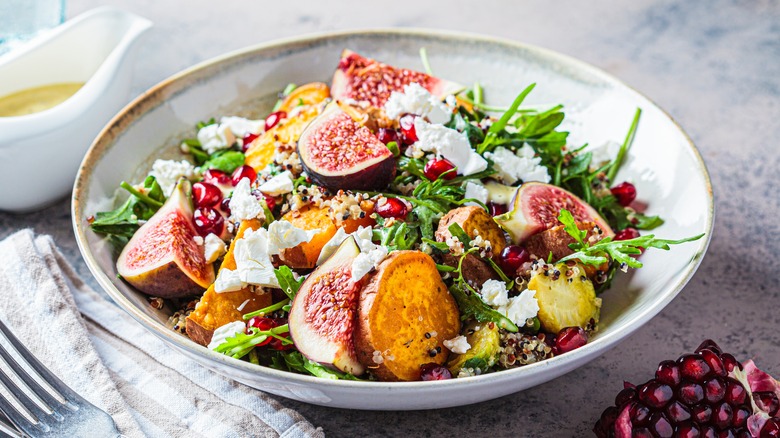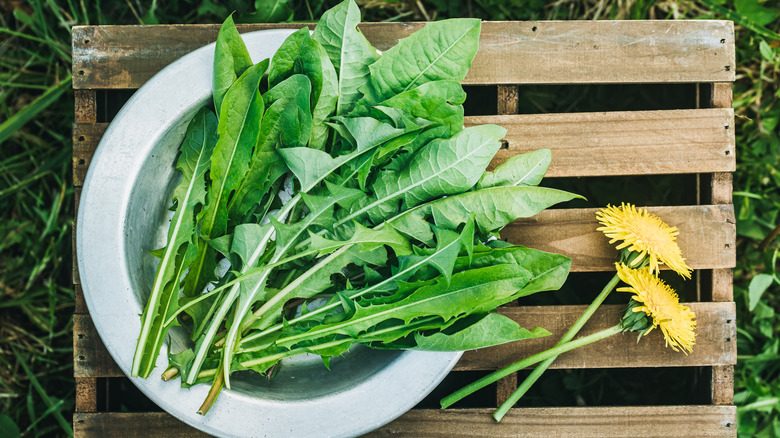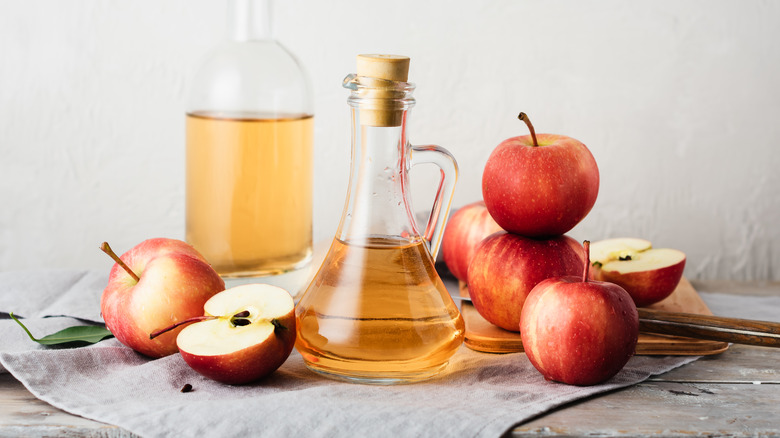Warm Apple Cider Dressing Is The Perfect Pairing For Fall Salads
Autumn and its chilly, crisp weather provides countless cooking opportunities. One of these is the opportunity to change up your salad game by trading in summer's cool, refreshing vegetal elements for warm, roasted varieties. It's the time for sweet butternut squash and cranberries, earthy Brussels sprouts, and peppery arugula, dressed with the apple-y tartness of a warm apple cider vinaigrette. Cozy combinations like these will highlight and perfect any number of fall salad preparations.
There are several different recipes for apple cider dressing, certainly not all of them warm. In essence, the process boils down (sometimes literally) to creating a canny, balanced combination of bitter, sweet, savory, and salty. What's enviable about this rendition is the combination of apple cider (or juice) along with apple cider vinegar, providing a spectrum of apple essence ranging from sweet to sour. Since most vinaigrettes, like many salad dressings, are emulsions — that is to say, they're a temporary blend of two ingredients that don't like to combine — a good apple cider dressing will also contain oil. (To this point, you can seek out a better match than a high-quality, fruity olive oil, but you probably won't succeed.) But what's up with the warm part?
Pairing options for warm apple cider dressing
Normally, you wouldn't add liquid to a vinegar and oil emulsion like a salad dressing, so how exactly do you include apple cider? First, you have to understand what it is. There's not much difference between apple juice and apple cider besides seasonality and processing. Cider, the stuff that rolls up every autumn, tends to be unfiltered and unpasteurized, so what you're getting is pure apple flavor. The simple way to turn it into a salad dressing is by putting it (along with its cousin, apple cider vinegar) in a saucepan, perhaps with an aromatic like minced shallots, and making a pretty significant reduction. This will both concentrate the flavors of the apple-based ingredients and tame the onions. After that, simply add whatever other dressing ingredients you like.
As for what kind of salad you should dress with this bit of autumnal magic, just look for anything you'd normally pair with apples: veggies like endive, fennel bulb, or roasted butternut squash; greens like arugula or spinach; nuts like toasted pecans or walnuts; and even dried fruits like cranberries, golden raisins, or currants. In fact, a warm apple cider dressing is the perfect opportunity to explore a warm salad.
Apple cider dressing is a historical favorite
A warm vinaigrette has special properties that cold varieties don't capture. First, it will be more aromatic by nature. Any dried herbs used in the recipe will be brought to life. Second, warm dressings are often simmered, allowing for normally harsh-tasting ingredients like minced shallots to mellow and sweeten. Lastly, a warm vinaigrette is better suited to complement and tame the qualities of delicious greens like endive, dandelion, escarole, and arugula that are robust and even a little bitter.
Warm salads are well-established as a great idea because they have such a long history. A written recipe for one appears in "A Forme of Cury," published in 1390, which includes borage, mint, rosemary, fennel, leeks, and onions. The tradition continues with warm salads featuring bacon vinaigrettes, mesclun, roasted root vegetables, hot potatoes, and poached eggs. Constructing your own warm salad featuring an apple cider vinaigrette will likely result in something less heavy and more zingy — a great way to welcome the first chilly days of winter.


